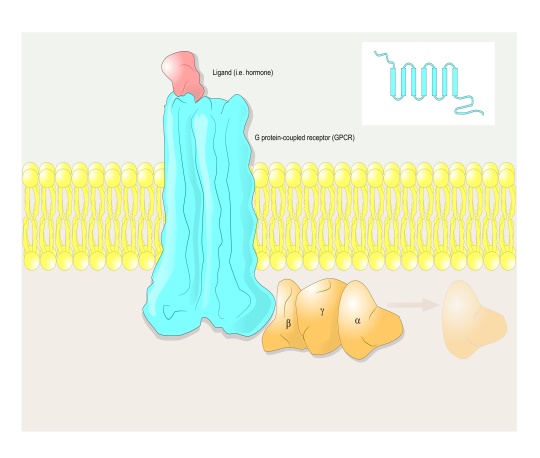Signal Transduction
The Introduction of Signal Transduction

In the field of biology, signal transduction mainly refers to cell signal transduction. Cell signal transduction refers to the process in which a cell experiences the stimulation of information molecules through the membrane or intracellular receptors and is transformed by the intracellular signal transduction system, thereby affecting the biological function of the cell. Water-soluble information molecules and prostaglandins must first bind to membrane receptors, and initiate a cascade of intracellular signal transduction, and transmembrane transduction of extracellular signals into intracellular cells. Lipid soluble information molecules can enter the cell, bind to cytoplasmic or nuclear receptors, and induce specific cellular responses by changing the transcriptional activity of target genes.
The Classification of Signal Transduction and Their Characteristic
Currently, there are five known cell signal transduction pathways. In G protein-mediated signal transduction pathways, G protein can reversibly bind to guanine nucleotides. Heterotrimer composed of α, β and γ subunits mediates signal transduction between membrane receptors and effectors. Receptor tyrosine kinase (RTPK) signal transduction pathway, whose common feature is that the receptor itself has the activity of tyrosine kinase (TPK), and the ligands are mainly growth factors. The RTPK pathway is closely related to cell proliferation hypertrophy and tumorigenesis. After ligands bind to the extracellular region of the receptor, the receptor is dimerized and activated, and catalyzes the phosphorylation of tyrosine residues in the intracellular region. The common characteristic of non-receptor tyrosine kinase pathway is that the receptor itself does not have TPK activity, and the ligands are mainly hormones and cytokines. If ligands bind to receptors to make receptors dimerized, plc-beta can be activated through G protein-mediated activation or activation of plc-gamma by binding to intracytoplasmic phosphorylated TPK, thereby triggering a cascade of cellular signal transduction. Receptor guanosine cyclase signal transduction pathway, in which nitric oxide (NO) and carbon monoxide (CO) can activate guanosine cyclase (GC), and increase cGMP production; cGMP activates protein kinase G (PKG), and phosphorylated target protein plays a biological role. Nuclear receptor signal transduction pathway: intracellular receptors are distributed in cytoplasm or nucleus, which are essentially transcription factors regulated by ligands, and both initiate signal transduction and affect gene transcription in the nucleus, which are collectively referred to as nuclear receptors. Nuclear receptors can be divided into steroid hormone receptor family and thyroid hormone receptor family according to their structure and function. In conclusion, the cell signaling pathways include ligand receptors and transduction molecules. Ligands mainly include hormone cytokines and growth factors. Receptors include membrane receptors and intracellular receptors. The transduction molecules include small molecule transduction conductors, large molecule transduction proteins and protein kinases. Membrane receptors include seven transmembrane alpha helical receptors and a single transmembrane alpha helical receptor. The former membrane receptor mediated information pathways include PKA pathway, PKC pathway, Ca ion and calmodulin dependent protein kinase pathway and PKG pathway, and the second messenger molecules such as cAMP, DG, IP3, Ca and cGMP participate in the information transmission of these pathways. The latter membrane receptor mediates the TPK-Ras - MAPK pathway and JAKSTAT pathway. The ligands of intracellular receptors are steroid hormones, vitamin D3, thyroxine and retinoic acid, etc. Intracellular receptors belong to the inducible transcription factors, which produce transcription factor activity and promote transcription when combined with ligands.
The signal of extracellular information molecules is transmitted to the cell or nucleus through the cellular information pathway, and many biological effects are produced, such as the opening or closing of ion channels, the change of ion concentration, the change of enzyme activity, the change of substance metabolism, the change of gene expression and the impact on cell growth, development, differentiation and proliferation.
References:
- Davis R J. Signal transduction by the JNK group of MAP kinases. Cell. 2000, 103(2):239-252.
- Simons K, Toomre D. Lipid rafts and signal transduction. Nat Rev Mol Cell Biol. 2000, 1(1):31-39.
- Zhu J K. Salt and drought stress signal transduction in plants. Annual Review of Plant Biology. 2002, 53(53):247-273.